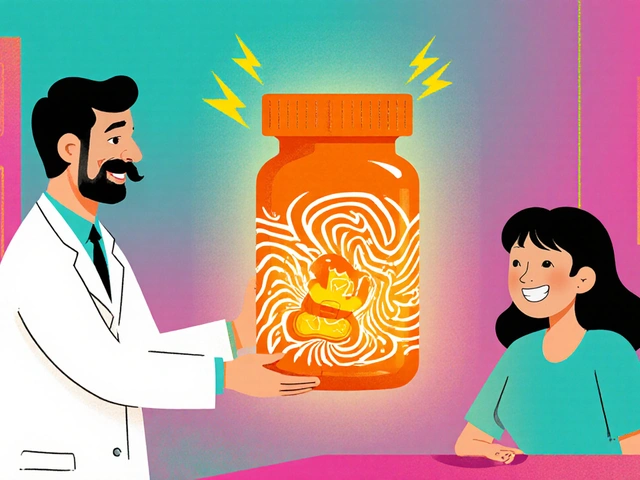Ask any doctor or nurse, and they'll tell you: amoxicillin is one of the most prescribed antibiotics out there. But what happens when it just doesn't cut it anymore? Bacteria are smart. They're evolving, dodging our tried-and-true meds, and making simple infections a whole lot more complicated. And let's face it, not every sore throat or sinus infection is a slam dunk for amoxicillin anymore. Understanding your options—especially combinations with clavulanate and backup drugs—could be the difference between kicking an infection fast or ending up in a stubborn medical standoff.
How Amoxicillin Works and Where It Fails
You probably already know amoxicillin knocks out a bunch of nasty bugs. It's in the penicillin family, and its sweet spot is crushing bacteria by wrecking their cell walls. Think of it like popping all the balloons at a kid's birthday party—eventually, there are none left. It covers a mix of Gram-positive bacteria (like Streptococcus pneumoniae) and some Gram-negative ones (like Haemophilus influenzae). That's why it's a go-to for everything from ear infections to some cases of pneumonia.
The big twist? Some bacteria have picked up a nasty habit—they make beta-lactamase, an enzyme that basically defuses amoxicillin. Suddenly, those balloons have armor. In the U.S. alone, more than 25% of Haemophilus influenzae strains in kids now resist plain amoxicillin. Hospital data from Europe isn't much brighter. When labs test urinary tract bacteria like E. coli, over 50% are resistant in some regions.
This mess means doctors can't just reach for amoxicillin and expect magic. If you've ever had a prescription swapped for 'something stronger,' you're not alone. But 'stronger' doesn't always mean 'better'—especially if resistance keeps creeping up. Now, let's look at how we can stack the deck with combos and backups.
Clavulanate Combinations: The Reinforcements
Enter the secret weapon: clavulanate. You’ll see it teamed with amoxicillin in co-amoxiclav, a gold-standard combo. Why? Clavulanate doesn’t fight bacteria directly. It handcuffs those crafty beta-lactamase enzymes and lets amoxicillin do its job. In a recent study of over 10,000 bacterial samples, adding clavulanate busted resistance in 85% of previously resistant bugs. Pretty wild, right?
But let's get specific. This combo wrecks many strains of Staphylococcus aureus (except the MRSA superbugs), Haemophilus influenzae, and some Escherichia coli. That's why doctors pick it for dental abscesses, sinusitis, and bite wound infections. One practical tip: if you’ve been prescribed 'augmentin,' that’s amoxicillin plus clavulanate. But it can’t save you from all resistance. Many urinary E. coli and hospital-acquired bugs still laugh at it.
Keep an eye out for side effects, too. The clavulanate piece is famous for causing a few more stomach issues than plain amoxicillin. Mild diarrhea is common, so drinking more fluids can help. It’s also best taken with food—helps your gut handle the punch.
Second-Line Antibiotics: When First-Choice Meds Crash
What if even the amoxicillin-clavulanate team gets benched? That’s when second-line antibiotics step in. Some of the most used are:
- Cephalosporins (like cefuroxime, cephalexin, cefixime): These cousins of penicillins expand coverage to more Gram-negative bugs. For instance, cefuroxime zaps many respiratory infections and some UTIs where amoxicillin flops. But they’re not magic bullets—resistance in E. coli is climbing fast, especially for oral agents.
- Macrolides (azithromycin, clarithromycin): Perfect if you’re allergic to penicillins. They take down organisms like Mycoplasma and atypical pneumonias, but strep and H. influenzae are learning to fight back. Resistance rates in Southern Europe now hit over 25% for key pathogens.
- Fluoroquinolones (ciprofloxacin, levofloxacin): Broad, powerful, but double-edged. They’re reserved for severe or resistant infections due to scary side effects—think tendon ruptures and nervous system glitches. E. coli resistance is also skyrocketing in urinary infections in North America and Asia.
- Doxycycline: Versatile against skin and respiratory bugs (including some MRSA in the community). Docs like it for tick-borne infections too, but many Gram-negatives ignore it.
What’s the takeaway? There’s no one-size-fits-all backup. Doctors pick second-line meds based on the bug, the infection site, and—often—local resistance stats. Sometimes, lab cultures guide the decision. If your infection keeps coming back, ask your doctor if sensitivity testing was done.
| Antibiotic | Active Spectrum | Common Resistance |
|---|---|---|
| Amoxicillin | Gram+ (Strep, some Staph), minor Gram- | Beta-lactamase producers, some E. coli |
| Amoxicillin-Clavulanate | Wider Gram+, better Gram- | ESBL E. coli, some Enterobacter |
| Cefuroxime | Gram+, many Gram- | ESBL Gram-, MRSA |
| Azithromycin | Atypicals, Streptococcus | Staph, some Strep, H. influenzae |
| Ciprofloxacin | Wide Gram-, moderate Gram+ | Rising E. coli, Pseudomonas |

Practical Tips for Patients and Providers
If you’re wondering how this all plays out when the rubber meets the road, here are some down-to-earth tips for both patients and the folks who prescribe:
- Always finish your course—even if you’re feeling on top of the world halfway through. Early quitters help resistance win.
- Your last UTI medicine may not work this time. Bacteria in your body aren’t the same every year.
- For providers: check the latest local resistance patterns before you grab your prescription pad. Most hospitals update their "antibiogram" at least once a year.
- Patients: if your doc wants to send a culture sample before picking an antibiotic, that’s a smart move, not a delay tactic.
- Consider allergies and past reactions. Penicillin allergies can steer the whole conversation into new territory, so mention them early.
And if you’re interested in learning the difference between all the common choices—like whether to stick with amoxicillin or try a new generation duo—check out this super practical rundown of amoxicillin similar drugs and how resistance shakes things up in the real world.
How Resistance Trends Are Reshaping Antibiotic Choices
Every year, more antibiotics lose their edge. The CDC estimated in 2024 that about 2.8 million antibiotic-resistant infections now hit the U.S. annually. Hospitals and clinics are switching gears, using backup choices earlier and even dusting off older, less convenient options.
One eye-opening fact: even newer combos, like ceftazidime-avibactam, are encountering resistance. It’s almost like a chess match between human ingenuity and bacterial evolution. More labs are running minimum inhibitory concentration (MIC) tests, finding out how much drug it really takes to stop a bug. That means more precise treatments—but also more expensive and complicated decisions.
If you travel or have family abroad, pay attention when you get sick. In some Asian countries, over 60% of E. coli from urine tests now resist amoxicillin—and the numbers aren't all that rosy in South America either. Carry a printout (or photo) of any recent cultures if you need care overseas. It could save days of guesswork and failed treatments.
Researchers are hustling, too: phage therapy (viruses that eat bacteria), new antibiotic classes, and even vaccines for certain infections are in the pipeline. But for the everyday person, sticking to smart prescription habits and not skipping doses can help slow resistance down.
Want a one-line takeaway? Every time you use (or misuse) an antibiotic, you’re helping shape which drugs work next year—both for you and for everyone else. That’s why listening to your doc about when antibiotics are (and aren’t) needed still matters, big time.
Cutting Edge: Staying Ahead of the Bacterial Curve
No one wants to play catch-up with superbugs. The best bet is mixing sharp science with a healthy dose of street smarts. Hospitals now use rapid polymerase chain reaction (PCR) tests to speed up bug ID—shaving days off guessing games. Some clinics are rolling out point-of-care bacterial 'fingerprinting' in under an hour, so you don’t sit on the wrong pill for days.
If you bounce between doctors, keep a personal record of what’s worked (and what didn’t) for you. Share this info, especially if you’ve had a resistant infection before. It could tip the scales toward a better choice next time. And if you see 'beta-lactamase positive' or 'ESBL' on a lab report, that means you’ll need more than plain amoxicillin—clavulanate or a higher-level backup.
The bottom line? Amoxicillin is still a workhorse, but the horses are getting tired. Clavulanate gives it a boost, sure, but the world of antibiotics is changing fast. Smart combinations, tested choices, and a skeptical eye toward resistance will keep you a step ahead, even when bacteria won’t stop fighting back.








July 12, 2025 AT 23:16
Vishwajeet Gade
amoxicillin is dead in india man. we got superbugs everywhere. doc gives cipro like candy. u finish the course? lol no one does. we just stop when u feel better. resistance? its already won.
July 13, 2025 AT 03:33
Samuel Wood
The notion that clavulanate is some sort of silver bullet is frankly, a bit naive. One must consider the pharmacokinetic profiles, the beta-lactamase isoenzyme diversity, and the fact that ESBLs are now plasmid-mediated and transmissible across genera. It's not just about adding an inhibitor-it's about evolutionary arms races at the molecular level.
July 14, 2025 AT 02:00
Jenni Waugh
Oh wow. So we're just supposed to trust doctors who prescribe antibiotics like they're giving out candy at Halloween? And you think people in the U.S. are the only ones misusing them? Honey, I've seen my cousin in Mexico get a Z-Pack for a cold. This isn't medicine. It's a global circus.
July 15, 2025 AT 11:51
Judy Schumacher
The systemic failure of antibiotic stewardship is not merely a clinical issue-it is a metaphysical collapse of the human relationship with microbial life. We treat bacteria as enemies to be annihilated, rather than as co-evolved entities that have, in fact, outsmarted us at every turn. The arrogance of pharmaceutical intervention is breathtaking. And yet, we still believe in the myth of control.
July 17, 2025 AT 10:58
Megan Raines
Wait, so if I had a UTI last year and it cleared with cephalexin, does that mean this year’s UTI might need cipro? Like… do my bacteria just upgrade their membership?
July 18, 2025 AT 22:57
Mamadou Seck
Clavulanate gives you more diarrhea than results honestly. I took it for a tooth infection and felt like i was being gut punched for a week. Amoxicillin alone was bad enough. Why do they even make this combo if it just makes you sicker
July 20, 2025 AT 03:15
Anthony Griek
I think it's important to remember that antibiotics aren't magic. They're tools. And like any tool, they wear out. The fact that we're still using 70-year-old drugs as first-line treatments says more about our healthcare system than about the bacteria. Maybe it's time to invest in real innovation instead of just swapping brand names.
July 20, 2025 AT 17:22
Norman Rexford
Man I remember when penicillin was a miracle. Now we got bacteria that laugh at our drugs. I think god gave us these bugs to teach us humility. Or maybe its just the government hiding the real cure so Big Pharma keeps makin cash. Either way, dont trust no doctor who dont ask about your travel history
July 22, 2025 AT 16:29
Wayne Keller
Just a quick tip: if your doctor doesn't mention local resistance patterns or ask if you've had antibiotics in the last 6 months, ask them why. It's not being difficult-it's being smart. And if they get defensive? Find a new doctor. Your body isn't a guessing game.
July 24, 2025 AT 09:46
Shana Labed
OMG I JUST HAD A SINUS INFECTION AND MY DOCTOR GAVE ME AUGMENTIN AND I FELT LIKE A SUPERHERO FOR A WEEK 😭😭😭 BUT THEN I GOT DIARRHEA SO BAD I HAD TO BUY 3 PACKS OF GUT HEALTH PROBIOTICS 😭😭😭 I'M LITERALLY A MICROBIAL WAR VETERAN NOW 🦸♀️💊
July 25, 2025 AT 23:28
California Daughter
Wait… so… you’re saying… amoxicillin doesn’t work for everything…? But… I thought it was the cure-all…? Like… what if… I just… took more? Or… maybe… I should’ve taken it with kombucha? Or… is this all just a conspiracy by the pharmaceutical industry to sell us more pills? I need to research this further… 🤔🔍
July 26, 2025 AT 06:56
Casey Crowell
Honestly? I think we need to stop seeing bacteria as enemies. They’ve been here way longer than us. Maybe instead of trying to wipe them out, we should learn to live with them. Like… maybe we need to stop being so aggressive with antibiotics and start being more… zen? 🙏🌿 #antibioticmindfulness